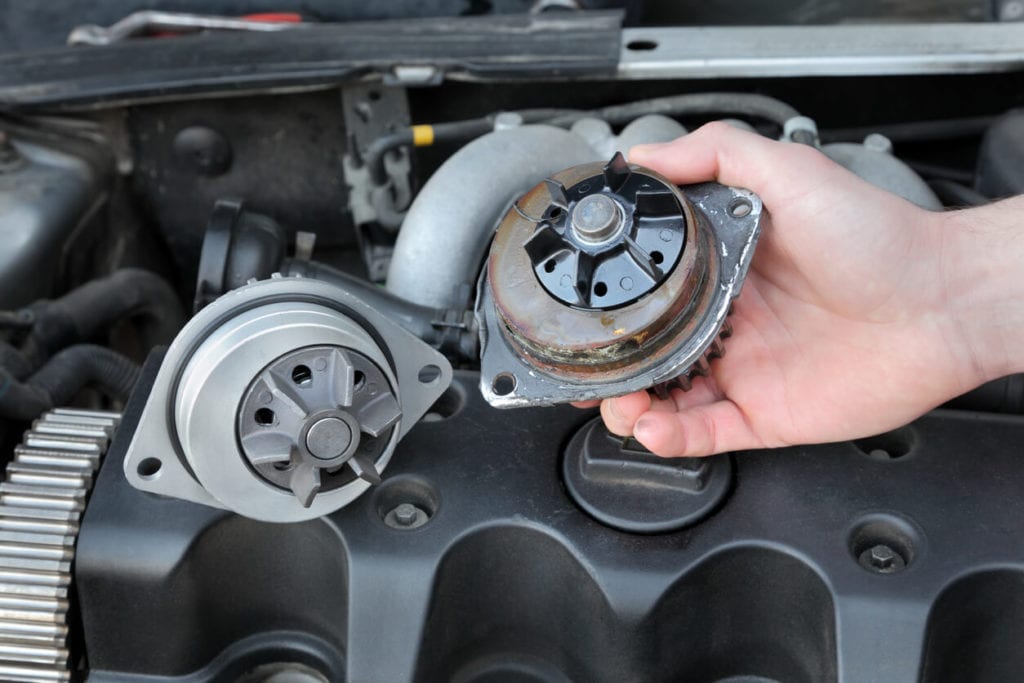What’s the one thing you need to survive a hot, summer day? If your answer was water, you’re correct. Like you, your car needs water to stay cool to keep from overheating. The engine can reach temperatures up to a scorching 195 to 220 degrees on an average temperature day, and even higher in the summer. That’s where coolant comes in. Coolant, actually a mixture of water and antifreeze, circulates through your engine to keep it cool, as controlled by the water pump. Here we answer your most burning questions about water pumps and how to know when something is wrong.

What Is a Water Pump in a Car?
In short, the water pump ensures the coolant keeps moving through the engine block, radiator, and hoses to help maintain a proper operating temperature.
What Does a Water Pump Do in a Car?
Using an impeller blade (a rotor used to increase the pressure and flow of fluid) and centrifugal force, it transports cooled water into the engine. Once the water has traveled around the engine, it continues through hoses to the radiator, where the water is cooled by the movement of air over the radiator’s fins. Then, it leaves the radiator, goes back into the water pump completing the cycle and beginning all over again. If the water pump is doing its job, the engine should be able to maintain a normal, consistent temperature.
What Makes Water Pumps Go Out?
- Worn water pump bearings. If loose enough, can cause belts to lose their grip and fall off.
- Water pump leaks. This is a sign that seals or gaskets have failed. If the shaft seal is the cause, the whole pump will need to be replaced. If it’s just the gasket, you may not need a whole new pump.
- Broken fan blades. Serpentine belt driven water pumps equipped with plastic flan blades can break creating vibrations and cause the water pump bearings to fail.
Symptoms of a Failed Water Pump
- A coolant leak in the center towards the front of your car. Gaskets and seals are meant to keep coolant inside the engine, but over time they will dry out, crack, or break causing the coolant to leak from the water pump.
- Corrosion of the water pump such as mineral build-up, rust, or contamination identified on the water pump. This is often caused by using the incorrect coolant, which makes cooling the engine more difficult on your vehicle.
- Loose water pump pulley. A high pitched or light thumping noise might be heard from the front of the vehicle caused by a loose serpentine belt. The buzzing pattern or whining reverberation is created as it circulates. Serpentine belts can snap off due to dryness, the pulley comes loose, or the bearings operating the water pump wear out.
- Engine overheating. If your water pump is not functioning, the coolant won’t be able to move through the engine to cool it off. Have a technician inspect your vehicle right away if your vehicle is overheating to avoid further damage. Damages from overheating include cracked cylinder heads, damaged head gaskets, or burnt pistons.
- Steam escaping from the engine. Unless it’s below freezing outside, you should not see any sort of steam rising from the front of your vehicle. Steam is a surefire sign that the engine is overheating. Pull over, open your hood to help the engine cool, and call for a tow truck to take your vehicle to an automotive repair center. Do not continue to drive with an overheated engine or you risk severe damages and costly repairs.
Servicing the cooling system can help prevent unexpected water pump trouble. Since coolant is a lubricant for the water pump and other cooling system components, ensuring the coolant is clean and pure is key. Routine maintenance such as coolant flushes every 30,000 – 45,000 and inspections will help prevent mechanical failures and overheating in your vehicle. Keep yourself hydrated, as well as your car, and you’ll both be able to travel for miles and miles.
